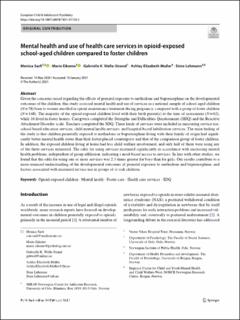| dc.contributor.author | Sarfi, Annamaria Monika | |
| dc.contributor.author | Eikemo, Marie | |
| dc.contributor.author | Welle-Strand, Gabrielle | |
| dc.contributor.author | Muller, Ashley Elizabeth | |
| dc.contributor.author | Lehmann, Stine | |
| dc.date.accessioned | 2021-07-07T14:15:12Z | |
| dc.date.available | 2021-07-07T14:15:12Z | |
| dc.date.created | 2021-02-17T10:32:17Z | |
| dc.date.issued | 2021 | |
| dc.identifier.issn | 1018-8827 | |
| dc.identifier.uri | https://hdl.handle.net/11250/2763838 | |
| dc.description.abstract | Given the concerns raised regarding the effects of prenatal exposure to methadone and buprenorphine on the developmental outcomes of the children, this study assessed mental health and use of services in a national sample of school-aged children (N = 78) born to women enrolled in opioid maintenance treatment during pregnancy, compared with a group of foster children (N = 140). The majority of the opioid-exposed children lived with their birth parent(s) at the time of assessment (N = 62), while 16 lived in foster homes. Caregivers completed the Strengths and Difficulties Questionnaire (SDQ) and the Reactive Attachment Disorder scale. Teachers completed the SDQ. Three kinds of services were included in measuring service use: school-based education services, child mental health services, and hospital-based habilitation services. The main finding of the study is that children prenatally exposed to methadone or buprenorphine living with their family of origin had significantly better mental health status than their foster-placed counterparts and that of the comparison group of foster children. In addition, the exposed children living at home had less child welfare involvement, and only half of them were using any of the three services measured. The odds for using services increased significantly in accordance with increasing mental health problems, independent of group affiliation, indicating a need-based access to services. In line with other studies, we found that the odds for using one or more services was 2.3 times greater for boys than for girls. Our results contribute to a more-nuanced understanding of the developmental outcomes of prenatal exposure to methadone and buprenorphine, and factors associated with increased service use in groups of at-risk children. | en_US |
| dc.language.iso | eng | en_US |
| dc.publisher | Springer | en_US |
| dc.rights | Navngivelse 4.0 Internasjonal | * |
| dc.rights.uri | http://creativecommons.org/licenses/by/4.0/deed.no | * |
| dc.title | Mental health and use of health care services in opioid‑exposed school‑aged children compared to foster children | en_US |
| dc.type | Journal article | en_US |
| dc.type | Peer reviewed | en_US |
| dc.description.version | publishedVersion | en_US |
| dc.rights.holder | Copyright the authors | en_US |
| cristin.ispublished | true | |
| cristin.fulltext | original | |
| cristin.qualitycode | 2 | |
| dc.identifier.doi | 10.1007/s00787-021-01728-3 | |
| dc.identifier.cristin | 1890735 | |
| dc.source.journal | European Child and Adolescent Psychiatry | en_US |
| dc.identifier.citation | European Child and Adolescent Psychiatry. 2021. | en_US |

